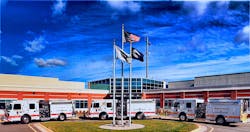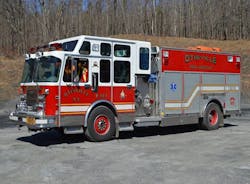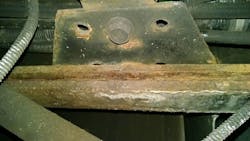An aging fleet, apparatus mechanical issues, lack of a defined replacement policy/plan, and no defined funding resources to support changes to the status quo are challenges that fire and rescue departments face daily.
Departments can overcome these challenges by having a fleet management program, looking at apparatus fleet studies, finding funding alternatives and, most importantly, having adequate insurance coverage to provide security in the event of an accident or catastrophic event.
Fleet replacement
One of the biggest challenges that a department faces is a fleet replacement. What are some of the mayday-style events that challenge and dictate fleet replacement? Things that need to be watched and reviewed that can help head off these challenges are an upfront reduction in capital funding for the fleet replacement program.
Pushing replacement out even one year can have long-lasting effects. Increased repair and maintenance costs are another signal that should alert internal stakeholders that budget constraints will be further challenged. Department personnel often have an emotional attachment to a particular apparatus and might discount or downplay the annualized operational costs. Here is where a robust fleet software system can track all repair, maintenance, fuel, insurance and depreciation costs to determine the actual cost of ownership.
Another concern is when you determine that reserve units are spending the majority of their service life backfilling for frontline units and might be the most active vehicles in the fleet.
Among the first questions that you must ask are: Do we have a fleet management program? What is needed to improve the fleet situation?
When developing a good fleet management program and sound fleet management practices, departments need to start with data analysis of records on usage, repair and maintenance costs, downtime, fuel, insurance and certification testing. The department also must look at the annual cost of ownership to determine where these costs exceed the residual value in the vehicle. This amount can vary from vehicle to vehicle even with a standardized engine and truck fleet.
Evaluation of the apparatus fleet is the foundation of a good apparatus plan. An evaluation is made up of identifying cost of ownership issues and apparatus life cycle costs, which include service life, technological life and economic life.
Service life is the amount of time that the apparatus can render service to the community. Technological life considers obsolescence compared with a new vehicle that’s built using today’s technology in manufacturing, safety and operational aspects. Economic life refers to the effect that the vehicle’s maintenance, testing and downtime have on the department's capital and operating budgets.
After evaluation of the fleet, apparatus replacement should be planned well into the future—5–10 years—depending on the local government’s planning cycle. The plan should be approved by the administration, should include the budget office and should be built into the annual budget process.
There are four basic fleet replacement options: buy all units new through outright purchasing; lease units, returning or purchasing/buying them out at end of lease; rehabilitate now/replace later; and buy used apparatus.
A good fleet management program starts with annual testing and certification for all units, a comprehensive preventive maintenance program, and a fleet software system where all costs can be captured and analyzed.
When putting together a fleet management program, don’t try to fix staffing issues with poorly designed or overcomplicated apparatus. Many departments design the “Swiss Army knife,” multipurpose apparatus, only to find that, although the vehicle carries a little bit of everything, it doesn’t perform any function particularly well. Additionally, when reviewing your fleet, pay particular attention to confirming the in-service front- and rear-axle weights on an annual basis to ensure that each vehicle is within the axle and component ratings.
When doing a fleet study, consider the following objectives: Evaluate each unit for age, mechanical condition, repair and maintenance costs, corrosion issues, pump and aerial inspection results along with the anticipated remaining service life. Inspections of all components (including chassis, tire condition and age, body compartmentation, confirmation of in-service weights and any accident repair records) should be under consideration.
Depending on the department’s response district, structural conditions and other demographic concerns, projections for the appropriate fleet size for engines, trucks and special service apparatus can be determined. For example, a department that operates out of four stations runs the following apparatus: six wagons/engines that have an average age of 13.88 years old and two rear-mount ladder trucks that have an average age of 20 years old. The department’s past vehicle history has one new apparatus purchased every nine years.
Each department’s existing fleet purchase history needs to be looked at as a component of any study. In this case, the department’s apparatus purchases were as follows: Company A purchased four units between 1997–2010 (13-year span); Company B purchased two units between 1998–2004 (6-year span); Company C purchased four units between 1996–2009 (13-year span); and Company D purchased four units between 2001–2008 (7-year span).
Another key component is the annual vehicle mileage (AVM). In this case, the AVM for all frontline engines was 5,580 miles per year, and the average for the truck company units was 4,709 miles per year. Using this information, you can calculate the AVM for a new engine and help set your replacement plan. For example, based on the above information, the AVM for a new engine after 12 years was 80,760 miles; after 15 years, it was more than 100,000 miles.
Another area to study is the repair and maintenance costs of apparatus. In this department, during 2014–2015, $188,155 was spent on apparatus maintenance. Armed with this information, the operational cost per mile was developed for the apparatus. For example, Wagon A was $6.38, Engine A was $2.17, Truck 2 was $4.72 and Ladder 2 was $15.14. The older units showed the higher costs.
Based on the study findings, an apparatus fleet replacement plan found that all engine company apparatus should be replaced at 12 years at an approximate mileage of 80,000, and ladder trucks should be replaced at 15 years at a top-end mileage of 75,000 miles. Many departments don’t consider resale or trade-in value, because funds might not be returned to the department. Many smaller departments find that the cost of new vehicles simply is beyond their financial reach, and good condition, well-maintained apparatus enjoy a significant residual value, which can be used to partially fund replacement units.
An annual apparatus inspection program should be instituted following NFPA 1911: Standard for the Inspection, Maintenance, Testing, and Retirement of In-Service Emergency Vehicles. Apparatus weight must be considered, because it has far-reaching safety implications. All units that are in the department fleet should be subject to confirmation of in-service weight as per Section 16.2.3 of NFPA 1911. Overweight apparatus isn’t relegated to older vehicles. Unfortunately, new apparatus easily can become overweight when undersized axles and suspension components are used along with equipment caches that weren’t discussed at the time of preconstruction with the manufacturer and when everyone assumed that things would work out. New apparatus often can be overlooked as being compliant with both NFPA and local jurisdiction weight limits on axle loading.
When completing a study, the fleet replacement options need to be laid out to make sure that you do what is right for those who serve and those who are served.
Apparatus purchasing
When purchasing a new apparatus, are you writing your specification, using a manufacturer’s specification, or soliciting request for proposals for review by the department’s apparatus committee? Buying a new apparatus is a complex process. If your department doesn’t have a fleet manager or personnel who have extensive technical expertise, it might be beneficial to seek outside help.
Another option is a lease or lease purchase. With a lease-purchase option, a department can spec out an apparatus, pay lease payments for 5–7 years and have a predetermined buyback amount, which enables funding for replacement units. With a lease option, a department can spec out an apparatus for a specific time frame and spread the cost over several years. This enables the department to acquire new apparatus when needed. It also guarantees a residual value that’s based on vehicle condition, mileage and maintenance.
Purchasing authorities and cooperative purchasing groups can provide a department with the ability to determine which original equipment manufacturer (OEM) they want to deal with while having visibility to standard components and optional equipment costs for consideration.
Rehab or rebuilding
Rehabbing or rebuilding apparatus has its ups and downs. You must consider the following if looking at this avenue: the department is unable to afford new apparatus; the mission of the apparatus changed; the department desires to upgrade specific components to enhance operations, maintenance and safety and extend the life expectancy of the vehicle.
If your department plans to rebuild a vehicle, first determine the length of time that the unit will continue to provide frontline service before a new vehicle will be acquired. Spending $150,000 to upgrade warning lights, paint and graphics with a change in tires and wheels might not work out if you plan to keep the unit for five years, because these upgrades will do little to ensure the mechanical reliability of the unit.
Reasonable candidates for rebuilding projects include: custom cab apparatus that have solid frame components; vehicles whose OEM is in business to support replacement parts; and vehicles whose major drivetrain components are in good condition to provide the additional life cycle.
Poor candidates are: apparatus that are older than 15 years; 2000 vintage units; apparatus for which major components aren’t available; apparatus whose current use is marginal, because they are underpowered or handle poorly; and previously rebuilt apparatus.
Fleet funding
If the department is looking at funding alternatives, some successful funding programs that are outside of the normal government capital improvement budget deserve consideration. The first is where the governing body provides at least 60 percent of the base price of the apparatus (engines and trucks). This works well for volunteer and combination systems. The next is a revolving apparatus sinking fund that’s based on an apparatus replacement schedule for engines, trucks and rescues. Volunteer companies are offered a 0 percent loan for the life of the apparatus, and loan payments go back into the fund to keep it solvent. The municipality injects funds regularly to make sure funds remain financially solvent. The governing body covers 100 percent of the cost of the engines and trucks based on a standard set of specifications, with the company responsible for anything else.
The main point of fleet plan funding is to make sure that the replacement schedule is realistic, that the funding can be maintained and projected, that funding keeps pace with the economy, that you leave some wiggle room in case of difficult times and that you might have to move replacements back some.
Insuring the fleet
A major concern for any fleet and its plan is insurance coverage. Do you know what coverage you have, and do you understand it? The biggest item to understand: agreed values. There are several assumptions made by clients and prospects as to the process of determining how (or whether) the apparatus is repaired or replaced after an accident or damage occurred. Placing the proper value on the apparatus is important to both department and insurer.
The time to know how agreed value works isn’t after the accident happened but before insurance claims. Ask your insurance carrier the following when starting to set an agreed value on a vehicle:
- What is the current value of the vehicle?
- What is the replacement cost of like kind and quality? (The agreed value should be somewhere in between.)
If agreed value is less than the actual cash value of the vehicle, the agreed value coverage could penalize the insured at the time of loss. If agreed value is more than the replacement cost value, the insured is paying the premium on the coverage that they never will collect. What amount of money—particularly on older vehicles—would the insured want to invest in a repair before they would say they didn’t want to put any more money in?
Every insurance provider is different, but we will use this example from one of the largest emergency services organization insurance carriers. In this case, the carrier will pay the least of the four items:
- The cost of repairing damaged apparatus.
- The cost to replace a part(s) of the damaged apparatus as of the time of the loss with a part or parts of like kind and quality, without deduction for depreciation.
- The cost to replace the entire covered apparatus and its permanently attached equipment as of the time of the loss with a comparable new vehicle and permanently attached equipment that’s manufactured to current specifications or standards set by nationally recognized organizations, such as NFPA or the U.S. Department of Transportation.
- Limit stated in the declarations as applicable to the damaged or stolen property.
The first and second items apply when the loss is partial. If a partial loss is on an older vehicle, the replacement parts might be of the refurbished type. This might be a necessary approach to repairs if new parts no longer are available. The third and fourth items apply when a vehicle is determined unable to be repaired. The policy will pay the lesser of the third or fourth items. It won’t pay for a comparable new vehicle at $450,000 if the agreed value is only $200,000.
Lessons learned
Have a third party complete a fleet study that’s based on a set of expectations and what the report will do for the department when completed. Department leaders must: build common ground with all who are involved; identify and work through objectives; be willing to work hard to sell the plan; make sure the governing body is invested and buys in; and look out for (but honor) pride and tradition.
Make sure that there is involvement at all levels. Strong, upfront political support for a study and replacement program must be a first step of the process to be successful.
Take your time, do your research, and do the math when looking at putting together or having someone do a fleet study for you. There is a lot to consider to do it correctly, and, remember, you are laying the groundwork for the department’s future and leaving a legacy.
Special thanks to Chief Joseph Cardello of Stafford County, VA, Fire & Rescue Department; Chief Jerry Poland of Bonneauville, PA, Fire Company; and Tom Shand of Emergency Vehicle Response for help with this article.
About the author
Allen Baldwin started his fire service career while he was in high school. He currently serves as the assistant fire and EMS chief, operations command, for the Stafford County, VA, Fire & Rescue Department. He also serves as the president of the Cumberland Valley Volunteer Firemen’s Association. Baldwin holds a master’s degree from Waldorf University, a bachelor’s degree from Point Park University and an associate degree from the Community College of Allegheny County.
In Excess of 75 Percent
About the Author
Allen Baldwin
Allen Baldwin started his fire service career in Wilkins Township, PA, while he was in high school. He currently serves as the assistant fire and EMS chief, operations command, for the Stafford County, VA, Fire and Rescue Department. Baldwin holds a master’s degree in organizational leadership from Waldorf University, a bachelor’s degree in public administration from Point Park University and an associate degree in fire science from the Community College of Allegheny County.


